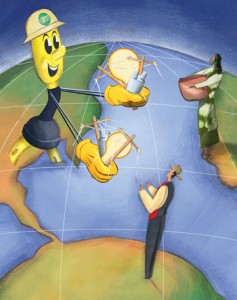 How do you build a better world? By changing one life, one farm, one village at a time.
How do you build a better world? By changing one life, one farm, one village at a time.
Driven by this premise, the nation’s consumer-owned electric cooperatives brought power and light to millions of rural residents across the United States 75 years ago, forever altering the economic fortunes of rural America. During the Kennedy administration, they began extending their “wired hands” of goodwill across the waters to bring a better life to undeveloped parts of the world.
Next year, Indiana’s electric cooperatives will join co-ops around the nation in marking the 50th anniversary of those shining — and continuing — international programs. In addition, the United Nations has designated 2012 as the “International Year of Cooperatives.”
To celebrate both significant developments, Indiana’s electric cooperatives are making plans to send their first international contingent of line crews to Guatemala next autumn.
Farming revolution
To understand why electric cooperatives are so enthusiastic about spreading the power of electricity, it’s important to remember how and why they started in this country.
As late as 1935, nearly 90 percent of rural residents were living in the dark — forced to rely on iceboxes or spring houses to cool food, kerosene lamps for lighting, wood stoves for cooking, and buckets and their backs to fetch water from wells. The reason: the big investor-owned utilities had decided that there was no profit to be made extending power lines into the countryside to hook up farms, rural residents and small towns.
That’s where the co-op business model came into play.
Farmers and other leaders realized central station electricity service would end the drudgery of rural life. After clamoring for relief for decades, they received a big shot in the arm in May 1935 when President Franklin D. Roosevelt signed an executive order creating the federal Rural Electrification Administration — now Rural Utilities Service. The agency’s mission: provide low-cost loans as well as engineering and administrative support to help electrify rural regions.
REA financing initially was meant to entice existing power companies to begin rural line construction. When they balked at that, too, it soon became clear rural electrification would only be accomplished by farmers and their rural neighbors doing it themselves by joining forces to form electric cooperatives. Consumers gave themselves and their communities a better, more productive and healthier way of life with electricity.
Work progressed quickly. By October 1940, electric co-ops nationwide were serving 1 million members. Innovations in line building pioneered by REA engineers and the competitive pressure co-ops placed on investor-owned utilities to serve rural areas slashed the cost of providing rural electric service by 50 percent or more.
Three-quarters of a century later, electric co-ops are still building a better future by delivering affordable electric service to 42 million members spread across 75 percent of the nation. But electric co-ops didn’t stop there.
Lighting the world
In 1962, at the invitation of President John F. Kennedy, the National Rural Electric Cooperative Association joined forces with the U.S. Agency for International Development to share electric co-op expertise and export the democratic, self-help cooperative model to undeveloped countries.
Teams of volunteer American electric co-op linemen began heading to foreign lands for a few weeks to teach local lineworkers safe work practices. Then NRECA staff would instruct locals how to maintain simple power grids and run their own utilities.
The theme for the International Year of Cooperatives is “Cooperative Enterprises Build a Better World.” That theme shines in the work NRECA International Programs has done every day for 50 years.
Working together, more than 300 U.S. electric cooperatives have delivered the benefits of safe and reliable electric service to more than 100 million people in 40-plus countries since November 1962.
Indiana’s electric cooperatives have long supported the International Programs through donations of dollars and equipment, but next fall two line crews made up of about a dozen volunteers from around the state will represent Indiana’s co-ops and consumers for the first time on foreign soil. They will serve two-week tours of duty building power lines to three rural villages in Guatemala that have no electricity (please see sidebar).
“We are excited to be part of this remarkable project,” said Bruce Graham, CEO of Indiana Statewide Association of RECs, which is coordinating the project with NRECA. “The International Programs are dedicated to bringing power to parts of the world that don’t have access to modern technology. Indiana’s line crews will change lives forever — much like our rural electric pioneers did for families across the nation 75 years ago. We can now pay it forward to the people of Guatemala.”
“Building a better world takes experience, and no group has more experience in bringing low-cost power to remote communities than electric co-ops,” said Glenn English, CEO of NRECA.
“We’re not only providing a service, we share knowledge and best construction practice skills on a lineman-to-lineman basis,” explained recent Guatemala volunteer Chris Stephens, manager of engineering for an electric cooperative in Georgia. “Those we help may speak a different language, but they speak the same work.”
Funding for this goodwill effort comes in part from the NRECA International Foundation, a registered charitable organization. NRECA International Programs projects are currently under way in Afghanistan, Bangladesh, Bolivia, Costa Rica, Dominican Republic, El Salvador, Guatemala, Haiti, the Philippines, South Sudan, Tanzania, Uganda and Yemen.
Much more to be done
In the United States, electricity has evolved from a luxury to an essential part of daily life. Yet more than 2 billion people around the globe still live without power — 64 million in Latin America, 500 million in Africa, and more than 1 billion in Asia.
According to NRECA International Programs, reliable electricity strengthens communities by providing better educational opportunities and increasing safety. Access to power also paves the way for progress, giving small business a much-needed boost.
“It was a humbling experience, to see the way people lived compared to what we have,” recalled Craig Carlan a lineman for another Georgia co-op who also recently returned from Guatemala. “In the village we electrified, kids will have the opportunity to get a better education. They have dreams, too, just like we have dreams. Maybe they can set higher goals now.”
Story by Megan McKoy-Noe, writer for the National Rural Electric Cooperative Association, with additional information by Electric Consumer staff.
To learn more about NRECA International Programs or assist with a tax-deductible donation, visit www.NRECAFoundation.coop. Please note “Indiana” to have your donation support Indiana’s linemen.



